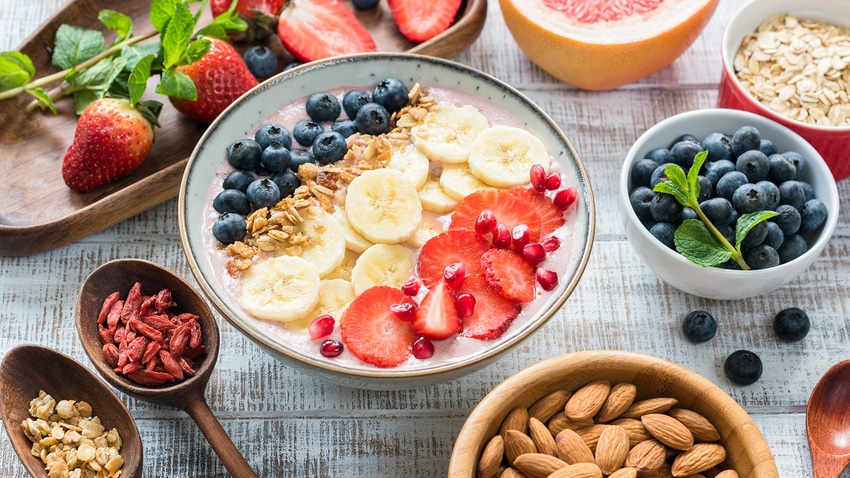Science debunks absolute rules, emphasizes functional foods’ matrix effect for post-workout nutrition
Post-exercise is a crucial time for consumers to give their bodies important nutrients, and for brands to offer products that help consumers lead better lives. It’s tempting to fall into “magic bullet” thinking when it comes to recovery and health benefits, but experts explain why consuming a range of whole foods is the optimal approach to take.

At a Glance
- Post-workout nutrition is best approached holistically, according to experts.
- Carbs and protein are both crucial for recovery, especially for athletes focusing on performance.
- A balanced overall diet that prioritizes whole foods over isolated nutrients is of utmost importance, experts contend.
The one-to-two-hour window after a workout is a powerful time for a number of reasons. Cravings can run high after a high-exertion session. The body is primed to take nutrients and put them to good use. And crucially, it’s also an opportunity to schedule healthy nutritional behaviors into our lifestyles — and repeat them over and over again.
It’s also tempting, however, to look for overly easy answers when it comes to post-workout nutrition. Consumers and brands are both guilty of falling into absolutist thinking. For example, consume exactly this much of this nutrient at this time, and definitely avoid this or you’ll be sabotaging your progress.
Over-prioritizing single nutrients and precise timing
A recent study out of King’s College London highlighted a new dimension of a familiar food. Overweight, middle-aged research subjects ate 2 ounces of almonds (57 grams or about 46 almonds) daily — with no guidance about when to eat them — while following a strenuous program of downhill running. They changed nothing else in their diet during the eight-week protocol, but quickly saw the payoff of their daily almond snack in the form of improved recovery, less muscle soreness and post-exercise muscle function. The benefit was more pronounced in the subjects who were new to exercise.

A tempting question to ask is: Which “magic bullet” ingredient in the almonds made such a big difference? That question misses the point, according to the study’s lead author, Oliver C. Witard, Ph.D., senior lecturer in exercise metabolism and nutrition at King��’s College London.
“The best explanation is this ‘matrix effect,’” Witard said. “When we look at what we’d call ‘functional foods,’ you’re not just looking at one ingredient. You’re looking at an interaction of different nutrients.”
Wittard pointed to the protein and branched chain amino acid content of the almonds, as well as fiber, antioxidant content and minerals. “You can’t pin it down to one ingredient,” he explained. “I think it’s a combination [of things].”
This answer may feel a bit unsatisfying to people looking to dial in tiny details of their diet, but Witard said the true value of functional foods is in their ability to deliver benefits even if the how, when and why aren’t totally clear.
“If you really want to optimize recovery, or if you’re an elite athlete, then it probably is a good idea to try and ingest one of these functional foods or including their protein source within that one-hour period after exercising,” he explained. “But it’s important not to blow this out of proportion. If you aren’t able to ingest this food within that first hour or 45 minutes, it isn’t going to be harmful. You’re still going to see the benefits.”
Thinking it’s all about protein
When she started regularly attending a CrossFit gym two years ago, Kéra Nyemb-Diop, Ph.D., lead nutritionist at Fonterra, found herself having to rethink her approach to eating. “I need to think about nutrition for performance,” she said. “Otherwise, I’m not going to be able to survive the workout every day.”
Unfortunately, the protein options she was seeing in stores only seemed like they were addressing half of what she was looking for. “Post workout, we need carbs and protein to recover,” Nyemb-Diop said. “But I haven’t found a post-workout shake yet with carbs and protein. All of them are a lot of protein, no carbs.”

In one sense, this problem is easily solved by having fruit or another carb-rich food along with her protein shake, according to Nyemb-Diop. In a larger sense, however, the ingredients label on most protein shakes is “a translation of the toxic message that the only reason we work out is to lose weight,” she said. This doesn’t match the needs of the increasing number of amateur athletes who are prioritizing muscle, strength and performance — not just leaning out.
“When you’re doing something like CrossFit, it’s immediate: If I get enough carbs, I can finish the workout,” Nyemb-Diop explained. “If not, I feel terrible. It’s right in front of you. I would love to find a product that is truly focused on recovery rather than weight loss.”
Overthinking fruits, vegetables
A popular lifestyle optimization and longevity influencer with well over a million followers recently made a splash by saying she kicked bananas out of her post-workout shake because the fruit “destroys the health benefits of a smoothie.” The reason? Bananas contain an enzyme called polyphenol oxidase that could block or degrade the flavonol content — and the health benefits — of other fruits like berries.
An instant onslaught of banana hate resulted from this post, until a few nutritionists and dietitians stood up for the trusty yellow fruit. Marie Spano, a sports dietitian for the Washington Nationals and other professional sports teams, was one of them.
Spano said the influencer misread the details of the study she relied upon for this “hot take,” since the flavonols in the study’s smoothie came from added cocoa flavonols, not actual foods. More importantly, the influencer was guilty of looking at one of the hundreds of nutrients that a banana — or any food — contains in tiny quantities, and letting it cause doubt about the overall value of the whole food itself.
“Some of this [misinformation] spirals into ridiculousness,” Spano said. “Only 12% of adults consume the recommended 1.5 cups to 2 cups of fruits per day. Why are we taking opportunities to take fruits out of the diet? That makes no sense.”
About the Author(s)
You May Also Like






